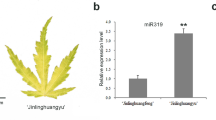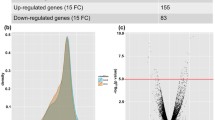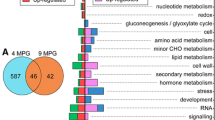Abstract
Key message
A long intergenic noncoding RNA LINC - AP2 is upregulated and negatively correlated with AP2 gene expression with Turnip crinkle virus infection in Arabidopsis.
Abstract
Plant vegetative growth and floral reproductive structure were severely retarded and distorted in Turnip crinkle virus (TCV)-infected Arabidopsis thaliana. Compared to mock-inoculated plants, the stamen filaments were shorter in flowers of TCV-infected plants. However, TCV-infected plants can still produce normal seeds through artificial pollination, indicating both its pollen and stigma were biologically functional. From our high-throughput RNA-Seq transcriptome analysis, a floral structure-related APETALA2 (AP2) gene was found to be downregulated and its neighboring long intergenic noncoding RNAs (lincRNA), At4NC069370 (named LINC-AP2 in this study), were upregulated significantly in TCV-infected plants. This LINC-AP2 was further confirmed for its existence using 5′RACE technology. LINC-AP2 overexpression (LINC-AP2 OE) transgenic Arabidopsis plants were generated to compare with TCV-infected WT plants. TCV-infected LINC-AP2 OE plants which contained lower AP2 gene expression displayed more severe symptoms (including floral structure distortion) and higher TCV-CP gene transcript and coat protein levels. Furthermore, compared to TCV-infected WT plants, TCV-infected ap2 mutant plants failed to open their flower buds and displayed more severe viral symptoms. In conclusion, upregulation of LINC-AP2 is negatively correlated with AP2 gene expression with TCV infection in Arabidopsis.






Similar content being viewed by others
References
Au PC, Zhu QH, Dennis ES, Wang MB (2011) Long non-coding RNA-mediated mechanisms independent of the RNAi pathway in animals and plants. RNA Biol 8:404–414
Aukerman MJ, Sakai H (2003) Regulation of flowering time and floral organ identity by a MicroRNA and its APETALA2-like target genes. Plant Cell 15:2730–2741
Bowman JL, Smyth DR, Meyerowitz EM (1989) Genes directing flower development in Arabidopsis. Plant Cell 1:37–52
Bustin SA, Benes V, Garson JA, Hellemans J, Huggett J, Kubista M, Mueller R, Nolan T, Pfaffl MW, Shipley GL, Vandesompele J, Wittwer CT (2009) The MIQE guidelines: minimum information for publication of quantitative real-time PCR experiments. Clin Chem 55:611–622
Dempsey A, Wobbe KK, Klessig DF (1993) Resistance and susceptible responses of Arabidopsis thaliana to Turnip crinkle virus. Mol Plant Pathol 83:1021–1029
Ding J, Lu Q, Ouyang Y, Mao H, Zhang P, Yao J, Xu C, Li X, Xiao J, Zhang Q (2012) A long noncoding RNA regulates photoperiod-sensitive male sterility, an essential component of hybrid rice. Proc Natl Acad Sci USA 109:2654–2659
Dinh TT, Girke T, Liu X, Yant L, Schmid M, Chen X (2012) The floral homeotic protein APETALA2 recognizes and acts through an AT-rich sequence element. Development 139:1978–1986
Fan C, Hao Z, Yan J, Li G (2015) Genome-wide identification and functional analysis of lincRNAs acting as miRNA targets or decoys in maize. BMC Genom 16:793
Gao R, Ng FK, Liu P, Wong SM (2012) Hibiscus chlorotic ringspot virus coat protein upregulates sulfur metabolism genes for enhanced pathogen defense. Mol Plant Microbe Interact 25:1574–1583
Gao R, Liu P, Yong Y, Wong SM (2016) Genome-wide transcriptomic analysis reveals correlation between higher WRKY61 expression and reduced symptom severity in Turnip crinkle virus infected Arabidopsis thaliana. Sci Rep 6:24604
Heo JB, Sung S (2011) Vernalization-mediated epigenetic silencing by a long intronic noncoding RNA. Science 331:76–79
Jabnoune M, Secco D, Lecampion C, Robaglia C, Shu Q, Poirier Y (2013) A rice cis-natural antisense RNA acts as a translational enhancer for its cognate mRNA and contributes to phosphate homeostasis and plant fitness. Plant Cell 25:4166–4182
Jin J, Liu J, Wang H, Wong L, Chua NH (2013) PLncDB: plant long non-coding RNA database. Bioinformatics 29:1068–1071
Jofuku KD, den Boer BG, Van Montagu M, Okamuro JK (1994) Control of Arabidopsis flower and seed development by the homeotic gene APETALA2. Plant Cell 6:1211–1225
Kaufmann K, Melzer R, Theissen G (2005) MIKC-type MADS-domain proteins: structural modularity, protein interactions and network evolution in land plants. Gene 347:183–198
Kunst L, Klenz JE, Martinez-Zapater J, Haughn GW (1989) AP2 gene determines the identity of perianth organs in flowers of Arabidopsis thaliana. Plant Cell 1:1195–1208
Lee SK (2014) What is the significance of long non-coding RNA HOX transcript antisense intergenic RNA in gastric cancer? Korean J Gastroenterol 63:137–139
Li L, Wang X, Sasidharan R, Stolc V, Deng W, He H, Korbel J, Chen X, Tongprasit W, Ronald P, Chen R, Gerstein M, Deng XW (2007) Global identification and characterization of transcriptionally active regions in the rice genome. PLoS One 2:e294
Liu F, Marquardt S, Lister C, Swiezewski S, Dean C (2010) Targeted 3′ processing of antisense transcripts triggers Arabidopsis FLC chromatin silencing. Science 327:94–97
Liu J, Wang H, Chua NH (2015) Long noncoding RNA transcriptome of plants. Plant Biotechnol J 13:319–328
Livak KJ, Schmittgen TD (2001) Analysis of relative gene expression data using real-time quantitative PCR and the 2(-Delta Delta C(T)) Method. Methods 25:402–408
Meng C, Chen J, Ding SW, Peng J, Wong SM (2008) Hibiscus chlorotic ringspot virus coat protein inhibits trans-acting small interfering RNA biogenesis in Arabidopsis. J Gen Virol 89:2349–2358
Moose SP, Sisco PH (1996) Glossy15, an APETALA2-like gene from maize that regulates leaf epidermal cell identity. Genes Dev 10:3018–3027
Nakano T, Suzuki K, Fujimura T, Shinshi H (2006) Genome-wide analysis of the ERF gene family in Arabidopsis and rice. Plant Physiol 140:411–432
Okamuro JK, Caster B, Villarroel R, Van Montagu M, Jofuku KD (1997) The AP2 domain of APETALA2 defines a large new family of DNA binding proteins in Arabidopsis. Proc Natl Acad Sci USA 94:7076–7081
Pelaz S, Gustafson-Brown C, Kohalmi SE, Crosby WL, Yanofsky MF (2001) APETALA1 and SEPALLATA3 interact to promote flower development. Plant J 26:385–394
Qu F, Morris TJ (1997) Encapsidation of turnip crinkle virus is defined by a specific packaging signal and RNA size. J Virol 71:1428–1435
Rymarquis LA, Kastenmayer JP, Huttenhofer AG, Green PJ (2008) Diamonds in the rough: mRNA-like non-coding RNAs. Trends Plant Sci 13:329–334
Sakuma Y, Liu Q, Dubouzet JG, Abe H, Shinozaki K, Yamaguchi-Shinozaki K (2002) DNA-binding specificity of the ERF/AP2 domain of Arabidopsis DREBs, transcription factors involved in dehydration- and cold-inducible gene expression. Biochem Biophys Res Commun 290:998–1009
Simon AE, Li XH, Lew JE, Stange R, Zhang CX, Polacco M, Carpenter CD (1992) Susceptibility and resistance of Arabidopsis thaliana to Turnip crinkle virus. Mol Plant Microbe Interact 5:496–503
Sun Q, Csorba T, Skourti-Stathaki K, Proudfoot NJ, Dean C (2013) R-loop stabilization represses antisense transcription at the Arabidopsis FLC locus. Science 340:619–621
Swiezewski S, Liu F, Magusin A, Dean C (2009) Cold-induced silencing by long antisense transcripts of an Arabidopsis Polycomb target. Nature 462:799–802
Theissen G (2001) Development of floral organ identity: stories from the MADS house. Curr Opin Plant Biol 4:75–85
Theissen G, Saedler H (2001) Plant biology. Floral quartets. Nature 409:469–471
Tissier AF, Marillonnet S, Klimyuk V, Patel K, Torres MA, Murphy G, Jones JD (1999) Multiple independent defective suppressor-mutator transposon insertions in Arabidopsis: a tool for functional genomics. Plant Cell 11:1841–1852
Trapnell C, Roberts A, Goff L, Pertea G, Kim D, Kelley DR, Pimentel H, Salzberg SL, Rinn JL, Pachter L (2012) Differential gene and transcript expression analysis of RNA-seq experiments with TopHat and Cufflinks. Nat Protoc 7:562–578
Ulitsky I, Bartel DP (2013) lincRNAs: genomics, evolution, and mechanisms. Cell 154:26–46
Wang KC, Chang HY (2011) Molecular mechanisms of long noncoding RNAs. Mol Cell 43:904–914
Wang XJ, Gaasterland T, Chua NH (2005) Genome-wide prediction and identification of cis-natural antisense transcripts in Arabidopsis thaliana. Genome Biol 6:R30
Wang H, Chua NH, Wang XJ (2006) Prediction of trans-antisense transcripts in Arabidopsis thaliana. Genome Biol 7:R92
Wang Y, Fan X, Lin F, He G, Terzaghi W, Zhu D, Deng XW (2014) Arabidopsis noncoding RNA mediates control of photomorphogenesis by red light. Proc Natl Acad Sci USA 111:10359–10364
Wright MW (2014) A short guide to long non-coding RNA gene nomenclature. Hum Genom 8:7
Wu HJ, Wang ZM, Wang M, Wang XJ (2013) Widespread long noncoding RNAs as endogenous target mimics for microRNAs in plants. Plant Physiol 161:1875–1884
Yu AD, Wang Z, Morris KV (2015) Long noncoding RNAs: a potent source of regulation in immunity and disease. Immunol Cell Biol 93:277–283
Zhang X, Henriques R, Lin SS, Niu QW, Chua NH (2006) Agrobacterium-mediated transformation of Arabidopsis thaliana using the floral dip method. Nat Protoc 1:641–646
Zhang L, Zhou XF, Pan GF, Zhao JP (2014) Enhanced expression of long non-coding RNA ZXF1 promoted the invasion and metastasis in lung adenocarcinoma. Biomed Pharmacother 68(4):401–407
Zhang H, Hu W, Hao J, Lv S, Wang C, Tong W, Wang Y, Wang Y, Liu X, Ji W (2016) Genome-wide identification and functional prediction of novel and fungi-responsive lincRNAs in Triticum aestivum. BMC Genom 17:238
Zhou H, Liu Q, Li J, Jiang D, Zhou L, Wu P, Lu S, Li F, Zhu L, Liu Z, Chen L, Liu YG, Zhuang C (2012) Photoperiod- and thermo-sensitive genic male sterility in rice are caused by a point mutation in a novel noncoding RNA that produces a small RNA. Cell Res 22:649–660
Acknowledgments
This work was supported by the National University of Singapore (NUS) research Grant R-154-000-655-112. We thank Yingna Ding for helping in RACE-PCR and generation of LINC-AP2 OE transgenic plants.
Author information
Authors and Affiliations
Corresponding author
Ethics declarations
Conflict of interest
The authors declare no conflict of interest.
Additional information
Communicated by N. J. Patron.
Electronic supplementary material
Below is the link to the electronic supplementary material.
Rights and permissions
About this article
Cite this article
Gao, R., Liu, P., Irwanto, N. et al. Upregulation of LINC-AP2 is negatively correlated with AP2 gene expression with Turnip crinkle virus infection in Arabidopsis thaliana . Plant Cell Rep 35, 2257–2267 (2016). https://doi.org/10.1007/s00299-016-2032-9
Received:
Accepted:
Published:
Issue Date:
DOI: https://doi.org/10.1007/s00299-016-2032-9




